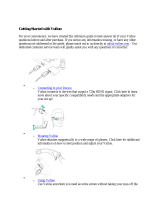
Table of contents - 3
TABLE OF CONTENTS
Register your Acer product ......................... 2
Manage your registered products ............... 2
First things first 6
Your guides ............................................. 6
Basic care and tips for using your
computer.................................................. 6
Turning your computer off........................... 6
Taking care of your computer ..................... 7
Taking care of your AC adapter .................. 7
Cleaning and servicing................................ 8
Your Acer notebook tour 9
Screen view ............................................. 9
Front view .............................................. 10
Keyboard view ....................................... 11
Left view ............................................... 12
Information on USB 3.0............................. 13
Right view ............................................. 13
Base view .............................................. 14
Using the keyboard 15
Lock keys............................................... 15
Hotkeys ..................................................... 15
Windows keys........................................ 16
Using the Precision Touchpad 17
Touchpad gestures................................ 17
Changing touchpad settings .................. 18
Recovery 20
Creating a recovery backup................... 20
Creating a drivers and applications
backup................................................... 22
Recovering your system ........................ 24
Reinstalling drivers and applications......... 25
Returning to an earlier system snapshot .. 27
Returning your system to its factory
condition.................................................... 28
Recovering from Windows ........................ 28
Recovering from a recovery backup ......... 31
Using a Bluetooth connection 34
Enabling and disabling Bluetooth .......... 34
Enable Bluetooth and add a device .......... 34
Connecting to the Internet 36
Connecting to a wireless network.......... 36
Connecting to a wireless LAN................... 36
Connecting with a cable ........................ 39
Built-in network feature ............................. 40
Connecting to a cellular network ........... 40
Acer Bluelight Shield 41
Acer ProShield 43
Overview................................................ 43
Setting up Acer ProShield...................... 43
Personal Secure Drive .............................. 45
Credential Manager ............................... 46
Fingerprint Registration* ........................... 46
Data Protection ...................................... 47
Data Removal ........................................ 47
BIOS utility 48
Boot sequence....................................... 48
Setting passwords ................................. 48
Securing your computer 49
Using a computer security lock.............. 49
Using passwords ................................... 49
Entering passwords .................................. 50
Power management 51
Saving power ......................................... 51
Battery pack 53
Battery characteristics ........................... 53
Charging the battery ................................. 53
Optimizing battery life ............................... 54
Checking the battery level......................... 55
Battery-low warning .................................. 55
Traveling with your computer 56
Disconnecting from the desktop ............ 56
Moving around ....................................... 56
Preparing the computer ............................ 56
What to bring to meetings ......................... 57
Taking the computer home .................... 57
Preparing the computer ............................ 57
What to take with you................................ 58
Special considerations .............................. 58
Setting up a home office ........................... 58
Traveling with the computer................... 58
Preparing the computer ............................ 59
What to take with you................................ 59
Special considerations .............................. 59
Traveling internationally......................... 59
Preparing the computer ............................ 59
What to bring with you .............................. 60
Special considerations .............................. 60
Universal Serial Bus (USB) 62
Memory card reader 63
Connectivity options............................... 63




















